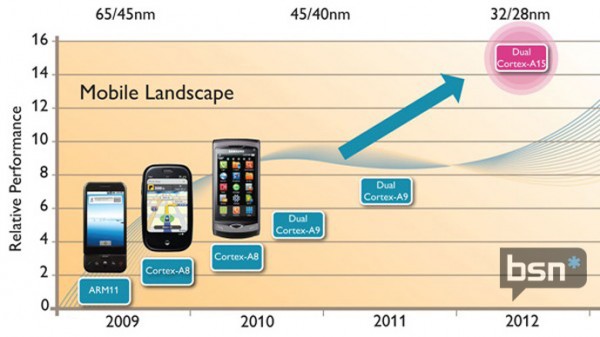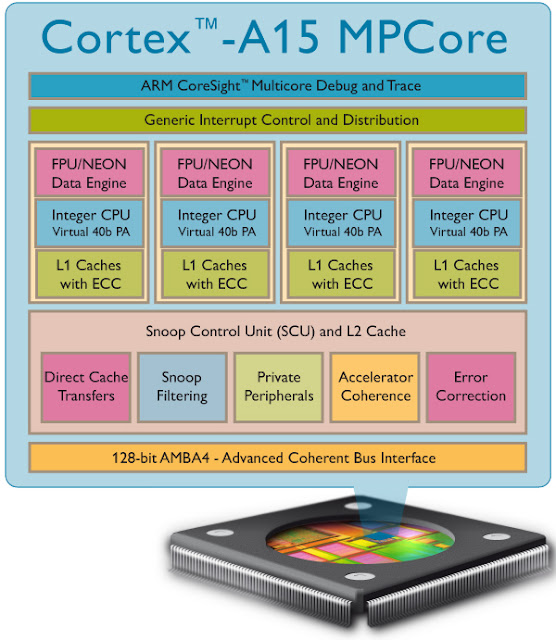VOYO A15
http://www.youtube.com/watch?v=eQmWo-fj_OY
VOYO A15
http://www.youtube.com/watch?v=ZNUuc3YCHZk
 |
| Fantastic Orient VOYO A15 |
ARM has completely dominated the mobile market for more than a decade, with over 90% market share, but it wasn’t until the rise of modern smartphones that we started to witness chips more powerful than anyone could have ever imagined we’d see in phones — chips that are now even starting to threaten Intel’s dominance and their status quo computing architecture.
Starting with the ARMv7 architecture and the first Cortex CPU based on it, the A8, we already began to think of these devices as superphones or mini-computers once the 1 GHz barrier was broken. Then came the dual core Cortex A9 chips and, with them, brought a browsing experience with rich graphics similar to what was available on PC’s just 6 or 7 years before that, which is still very impressive when you consider it’s all done on a mobile phone.
Fast forward to today, and we now have quad core Cortex A9 processors, and more. Despite this, I think many of us are already looking forward to the inevitable launch of chips based on the new Cortex A15 CPU, that promises to get ever closer to a level of performance that is good for laptops. this, all the while maintaining a low-power profile. So what can we expect from this next-gen chip compared to the Cortex A9 we’re using now?
In Fact, OrientDeal Have Published A Cortex A15 Tablet PC use Samsung Exynos 5250 CPU(Orient Voyo A15 - Best Samsung Galaxy Tab |iPad 4 Alternative - 11.6 inch Android 4.2 1.8Ghz Cortext A15 Samsung Exynos 5250 CPU 1920*1080IPS Screen 2GB RAM 16GB ROM). why ARM Cortex A15 Beyond Cortex A9. Lets Check all its Specification Details Below:
 |
| ARM Cortex A15 Beyond Cortex A9 |
If we go after DMIPS/Mhz, which might not be the best representation of performance, then Cortex A9 has 2.5 DMIPS/Mhz, while Cortex A15 has 3.5 DMIPS/Mhz, and some manufacturers are even promising 4.0 DMIPS/Mhz. So, the performance per clock compared to Cortex A9 should be 40%-60% higher, all things being equal. This is a huge improvement in efficiency.
Quick tip: DMIPS stands for Dhrystone Millions of Instructions per Second.
But things are not equal, so we should see Cortex A15 clocked at significantly higher frequencies as well. A dual core 2 GHz Cortex A15 chip like the upcoming Exynos 5250, should be around twice as fast a dual core 1.5 GHz Cortex A9 chip. And that’s even for single threaded performance, not like current quad core Cortex A9 chips like the 1.5 GHz Tegra 3 and 1.4 GHz Exynos 4 Quad which should only have 15%-25% higher single threaded performance compared to last year’s dual core 1.2 GHz Cortex A9 chips.
 |
| ARM Cortex A15 |
What about multi-threaded performance? Just because you double the cores, doesn’t mean you get double the performance, except in very specific situations. Really though, on average, you should get about a 50% increase in performance (could be much lower or much higher for specific tasks and apps). To make a simple comparison: if a dual core 2 GHz Cortex A15 is 2X faster than a dual core 1.5 GHz Cortex A9, we can still assume around 30% faster performance than today’s quad core processors for multi-threaded apps, even though it’s a dual core processor.
 |
| Cortex A15 MPCore |
Unlike Cortex A9, which was supposed to go up to 2.0 GHz per core (even though TSMC seems to have smashed that with their 3.1 GHz per core frequency), Cortex A15 is supposed to reach 2.5 GHz per core, something we’ll probably be able to see around mid-2013. Cortex A15 can also support up to 8 cores, compared to 4 for Cortex A9, so there’s room for growth there, too. Unlike Cortex A8 and Cortex A9 which only supported the NEON extension optionally for media acceleration (Tegra 2 didn’t have it and it suffered for it), Cortex A15 will have NEON integrated by default.
Although Cortex A15 is not a 64-bit processor, it can be extended to support up to 1 TB of RAM, which will be very useful in low-power servers. Another useful feature for servers, but also for those of us who like to juggle with many custom ROM’s or who might want to try another ROM without replacing their current one, is hardware virtualization. Of course this is something ROM makers would have to enable themselves for it to work, but I’m pretty excited about it, and it might even allow for faster upgrades for Cortex A15-based devices.
 |
| Mail-T604 Key features |
The first chip with a Cortex A15 CPU should be the Exynos 5250, and it’s expected to land sometime this summer or early fall. Although, it might appear as a dual core 1.7 GHz version, perhaps even in the upcoming Google tablet that will be announced at Google I/O. However, don’t get your hopes up to much, because Samsung might not want other companies (Asus) to be the first ones to use this chip.
It’s also expected to be integrated into Samsung’s 2560×1600 resolution tablet, the full 2 GHz version and with the Mali T-604, which should be the most powerful GPU this year by far. It should even handily beat the Adreno 320 if it’s only going to be 2X as fast as Adreno 225 as I suspect it will be. The Mali T-604 will be the perfect GPU for Cortex A15, thanks to the high integration with it, since both are made by ARM.
The Mali T-604 GPU promises 5x the performance of Mali 400 (the one in GS2, not GS3) will support Google’s Renderscript which is used to hardware accelerate the Android 4.0 UI and OpenCL. This can be used for much improved graphics, smarter AI in games, real time augmented reality apps and image processing such 3D games as Game Loft like <NOVA 3>, <Modern Combat:Zero Hour> ,<WildBlood>,<Batman3>,<Iron Man 3>,<Richman 4 fun>,<Bladeslinger>,<After Burner Climax>,<Real Football 2013>,<Dungeon Hunter 4>.
 |
| ARM Performance and enery efficiency graph |
Another exciting news is that Samsung might be using Cortex A15 in their Nexus phone this fall, and it might not even be the Exynos 5250 per se, but a variant using Cortex A7 as well and thebig.Little configuration for heterogeneous computing. I’m cautiously optimistic about this one because even though Cortex A7 is not supposed to appear until 2013, Samsung has mentioned before they will ship Cortex A7 this year. This feat and revelation is brought to us thanks to their close relationship to ARM.
The simple truth, for smartphones especially, you’re going to need something like a single core or even dual core Cortex A7 to make things more efficient for simple tasks. The exceedingly powerful Cortex A15 doesn’t have to wake up and use more battery. I’m also excited about Cortex A7 because I hope it’s going to replace the ancient ARM11 once and for all. It should enable a market for sub-$100 fast Android smartphones with dual core Cortex A7 chips.
 |
| ARMV8 |
While I’m very excited about the Cortex A15, Mali T-604 and Cortex A7, I’m even more excited for ARMv8 architecture, and new chips such as the successors of Cortex A15, Mali T6xx and Cortex A7 that will appear starting in 2014. ARM has been getting enormous demand for their ARMv8 architecture, which is still a couple of years away; the support for the 64 bit ARM architecture will be there from day one, rather than still having weak support for it many years later. This is the unfortunate case with Intel and AMD’s 64 bit architectures and this is why they lag behind in a market they helped initially create.
Whatever this means for Android, we shall see, but since everyone is going to support it, including theLinux community, and this means that many Linux operating systems will work by default on all future 64 bit chips! Potentially, it might make Android upgrades and installing Android on different devices a lot easier, too.
USB3.0 interface
Orient VOYO A15 as Samsung Galaxy Tab 3 plus clone is built in USB3.0 interface with the best peripherals scalability, which ensures the maximum efficiency of the built-in flash EMMC memory ,operating 3.0 standard reads speed, making the speed of the switch-on faster and running more smoothly to exert performance of the A15.
 |
| USB3.0 INTERFACE |

没有评论:
发表评论